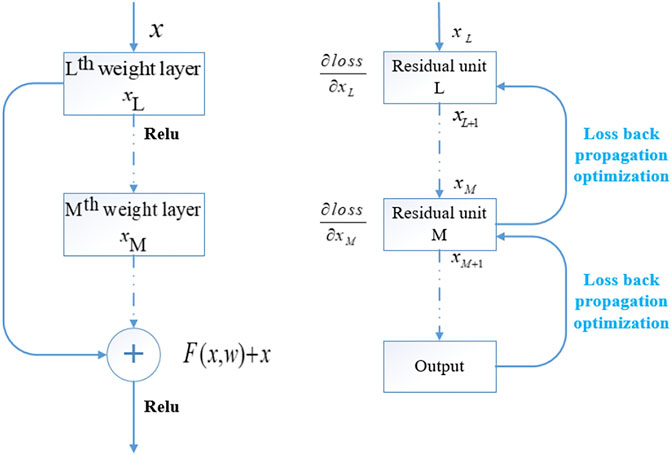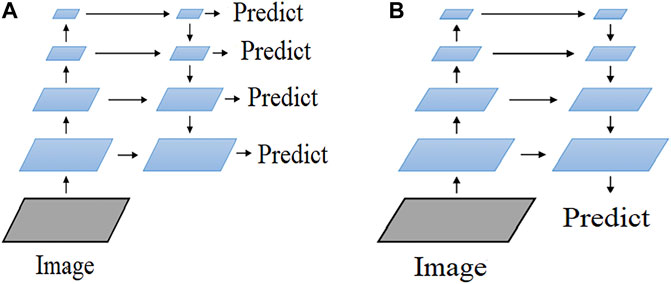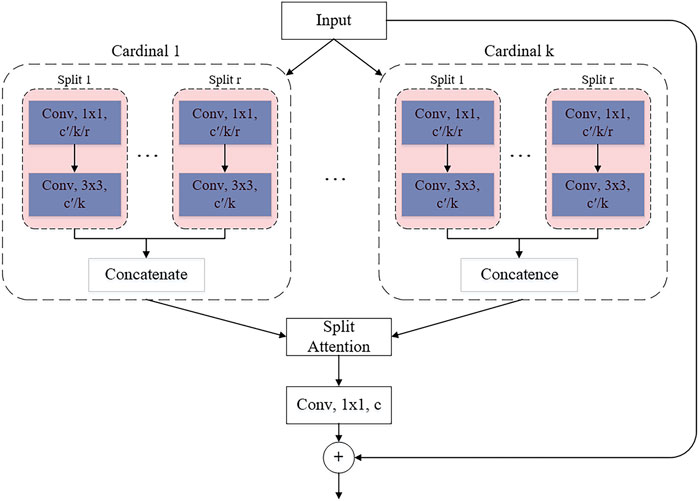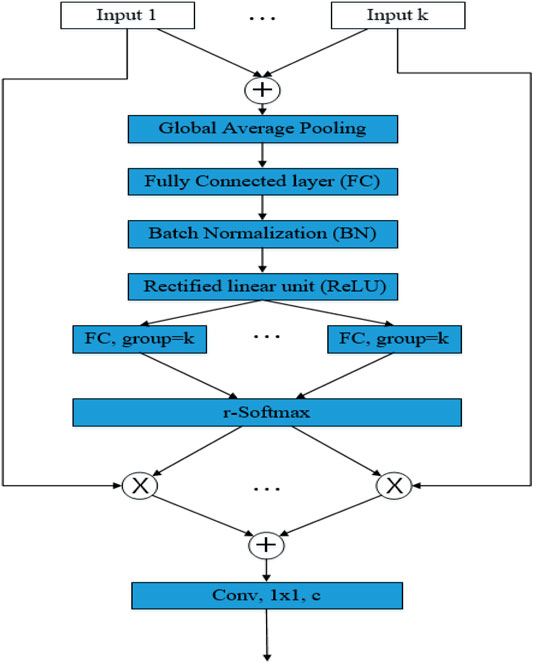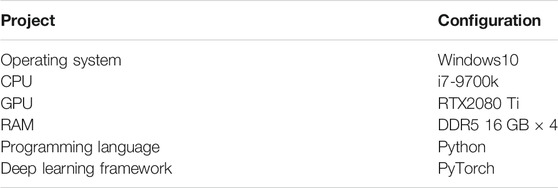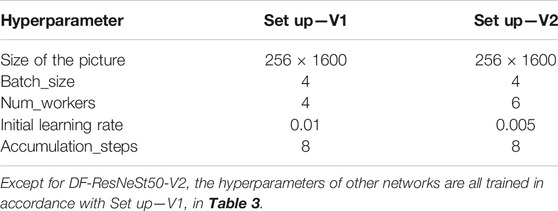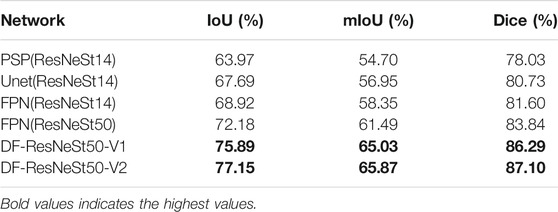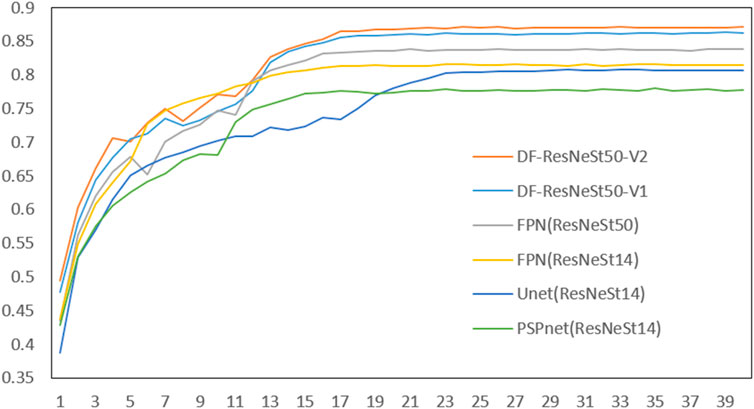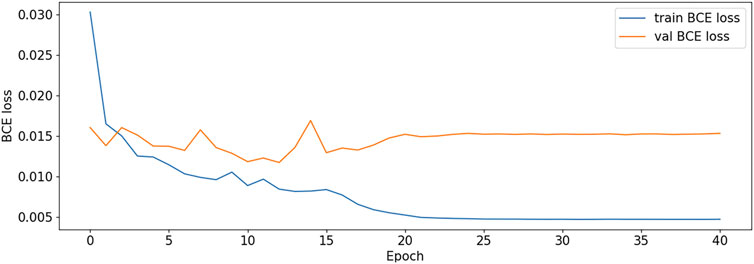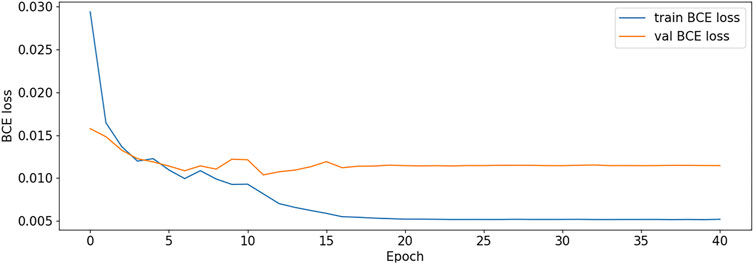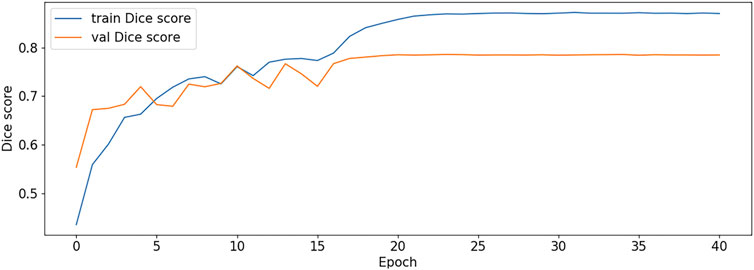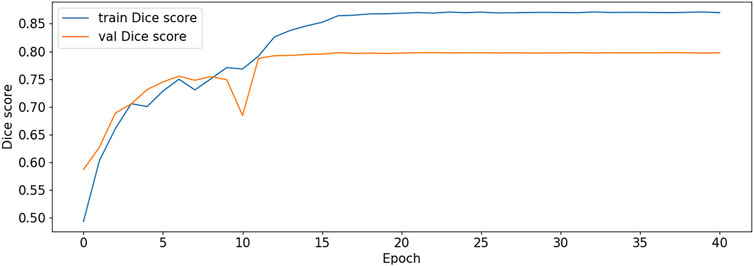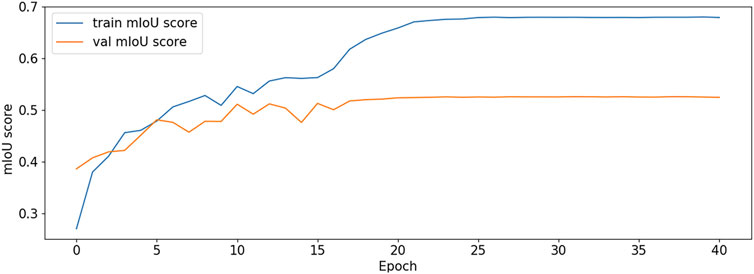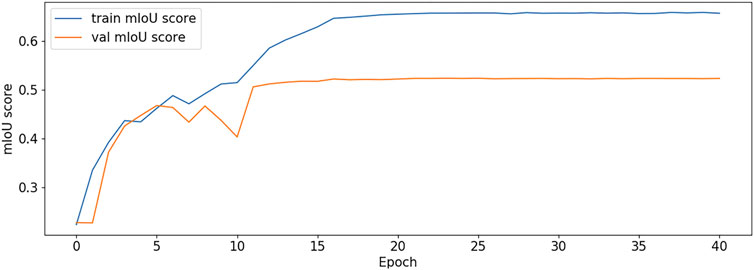- 1Key Laboratory of Metallurgical Equipment and Control Technology of Ministry of Education, Wuhan University of Science and Technology, Wuhan, China
- 2Hubei Key Laboratory of Mechanical Transmission and Manufacturing Engineering, Wuhan University of Science and Technology, Wuhan, China
- 3Precision Manufacturing Research Institute, Wuhan University of Science and Technology, Wuhan, China
- 4Research Center for Biomimetic Robot and Intelligent Measurement and Control, Wuhan University of Science and Technology, Wuhan, China
- 5Hubei Key Laboratory of Hydroelectric Machinery Design and Maintenance, Three Gorges University, Yichang, China
The intelligent monitoring and diagnosis of steel defects plays an important role in improving steel quality, production efficiency, and associated smart manufacturing. The application of the bio-inspired algorithms to mechanical engineering problems is of great significance. The split attention network is an improvement of the residual network, and it is an improvement of the visual attention mechanism in the bionic algorithm. In this paper, based on the feature pyramid network and split attention network, the network is improved and optimised in terms of data enhancement, multi-scale feature fusion and network structure optimisation. The DF-ResNeSt50 network model is proposed, which introduces a simple modularized split attention block, which can improve the attention mechanism of cross-feature graph groups. Finally, experimental validation proves that the proposed network model has good performance and application prospects in the intelligent detection of steel defects.
1. Introduction
The application of Bio-inspired computation and artificial intelligence technology is gradually taking an important position in the field of mechanical engineering. More specifically, bio-inspired algorithms can replace humans to a certain extent, through training and learning to complete the tedious task of detecting steel surface defects (Chen et al., 2021a; Yang et al., 2021; Yun et al., 2021, 2022). Research on steel plate defect detection based on visual attention mechanisms and bionic algorithms will help the steel industry move towards intelligence and information.
Currently, the detection of steel plate defects is still dominated by manual inspection, i.e., manual visual inspection or random sampling of products (Tang et al., 2017; Yu et al., 2019, Yu et al., 2020; Jawahar et al., 2020; Tian et al., 2020). However, manual inspection has problems such as strong subjectivity, limited vision and low efficiency, which to a certain extent restrict the intelligent and efficient production in the steel industry (Sun et al., 2020a; Sun et al., 2020b; Jiang et al., 2021b; Zhao et al., 2021). Meanwhile, eddy current inspection, infrared inspection, leakage magnetic inspection, laser scanning, and machine vision have facilitated the equipment-based inspection of steel, but there are still problems such as low speed and accuracy of defect detection.
For steel plate defects, the types of defects are complex and diverse, and there are many influencing factors, and the shape of defects will continue to change with factors such as process and environment, which adds many challenges to steel defect detection (Li et al., 2019a; Hao et al., 2021). Figure 1 shows the four typical steel plate defects: (a) Pit defect, (b) Edge crack, (c) Scratches, (d) Rolled-in scale.
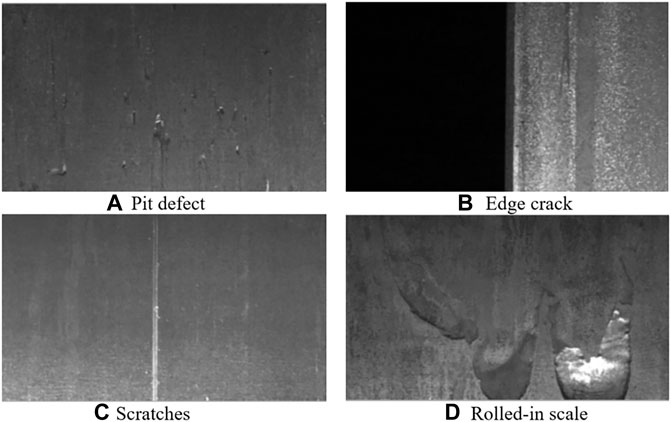
FIGURE 1. Four typical steel plate defects. (A) Pit defect, (B) Edge crack, (C) Scratches, (D) Rolled-in scale.
The key contributions of this work are:
1) The steel plate defect dataset is masked using Run-Length encoding, and the defect detection model is segmented using multi-scale feature fusion.
2) Based on the visual attention mechanism in the bio-inspired algorithms, combined with the feature pyramid network, on the basis of the residual network, a simple modular split-attention block is added, and the DF-ResNeSt50 network is proposed.
3) DF-ResNeSt50 network adopts radix-major to realize the block, the block is set to Cardinality = 2, Radix = 4, Width of bottleneck = 40. The proposed DF-ResNeSt50 algorithm is analyzed and compared with other classical algorithms. After experimental comparison, the network has better steel defect detection performance and detection efficiency.
The rest of this paper is organized as follows: Section 2 discusses the related work of steel plate surface defect detection in recent years. Section 3 briefly analyzes the data set, and proposes to use Run-Length encoding to compress the data and perform data preprocessing. In addition, an improved split-attention network based on the visual attention mechanism in bionic computing is proposed for residual networks and feature pyramid networks. Before network training, use mIou, Dice and other related indicators to monitor, and use Adam to dynamically adjust and optimize the learning rate. Section 4 compares and trains the proposed DF-ResNeSt50 network model after setting up the experimental environment and hyperparameters, and compared with other network models. Section 5 concludes the paper with summary and future research directions.
2. Related Work
In the surface defect detection system, image processing and analysis algorithms are important content. The usual process includes image preprocessing, target area segmentation, feature extraction and selection, and defect recognition and classification (Weng et al., 2021). As the requirements for the surface quality of steel plates become higher and higher, the requirements for real-time detection and recognition accuracy are also higher and higher. A large number of algorithms appear in each processing flow, and these algorithms have their own advantages and disadvantages and their scope of adaptation (Doulgkeroglou et al., 2020; Luo et al., 2020).
Compared with traditional manual features, the biggest advantage of deep learning is that it can automatically learn the performance of complex high-level features in the data, reducing the complexity of manual feature design. In recent years, deep learning has been successfully applied to speech recognition, image recognition, image segmentation, defect detection and other fields (Huang et al., 2020; Li et al., 2020).
In the application of deep learning, Çelik et al. (2014) designed a defect detection method that applies wavelet transform ideas to neural networks, and experiments have proved that this method has excellent defect detection performance (Long et al., 2015). Li et al. (2017) designed a stack noise reduction autoencoder based on the Fisher criterion and built a defect detection model based on this, which can improve the recognition rate of defect types to a certain extent (Xiao et al., 2021). Gu et al. (2019) established a detection and recognition model for cold-rolled steel sheet surface defects based on the deep learning target detection algorithm Faster R-CNN (Jiang et al., 2021b). The accuracy of the model on the verification set reached an average of 93%. He et al. (2020) introduced a transfer learning method, using feature extraction networks trained on large-scale data sets to greatly improve training efficiency.
At present, deep learning algorithms are rarely applied to the detection of steel surface defects. The above-mentioned intelligent detection method for steel plate defects based on deep learning still has problems such as low classification rate and low accuracy of defect target detection. In a complex environment, the stability and robustness of the neural network detection system is difficult to guarantee (Chen et al., 2021b; Duan et al., 2021).
With the widespread use of deep learning, convolutional neural networks will have better defect feature recognition and detection capabilities. In this paper, convolutional neural networks are used to intelligently detect defects in steel plates to improve the automation and intelligence of defect detection in the steel industry.
3. Data Analysis and Network Design
3.1 Data Analysis and Processing
3.1.1 Dataset
The steel plate defect dataset studied in this paper comes from the competition platform kaggle and the Russian steel giant Severstal. The data set contains 12,568 pieces of test set data and 1801 pieces of training set data. The vertical and horizontal resolutions of the picture are 256 and 1600 respectively.
As shown in Figure 2, in the training data, there are 5902 images without defects and 6666 images with defects. In a defective image, there are four types of defects, and the numbers of the four types of defects are not equal. Among them, 897 were pit defects, 247 were edge crack defects, 5,150 were scratch defects, and 801 were oxide scale defects. And, there are 6239 images containing 1 type of defect, 425 images containing two types of defects, 2 images containing three types of defects, and no images containing four types of defects.
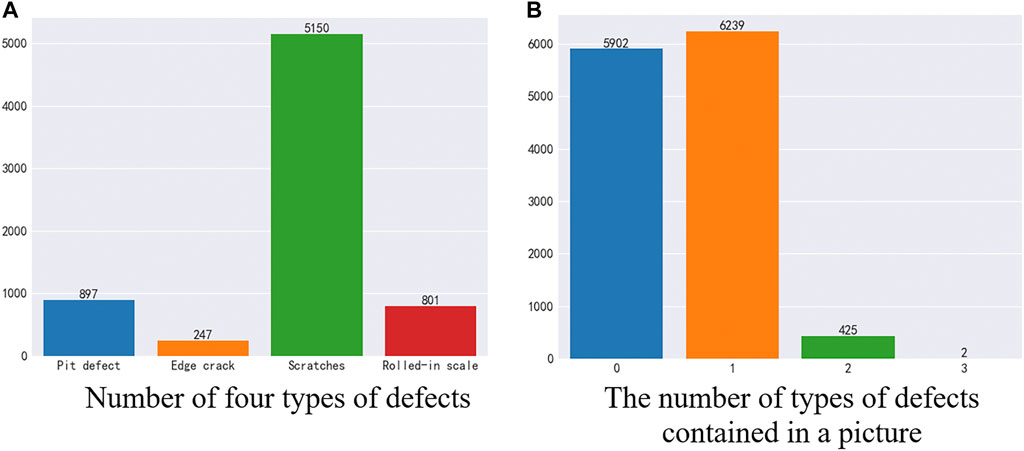
FIGURE 2. Training set analysis. (A) Number of four types of defects (B) The number of types of defects contained in a picture.
As shown in Figure 3, in the test set data, there are 858 images without defects and 943 images with defects. In a defective image, there are four types of defects, and the numbers of the four types of defects are not equal. Among them, 141 were pit defects, 49 were edge crack defects, 706 were scratch defects, and 97 were oxide scale defects. In each image, there are 893 images containing one defect, 50 images containing two types of defects, and no images containing three or four defects at the same time. As shown in Figure 3.
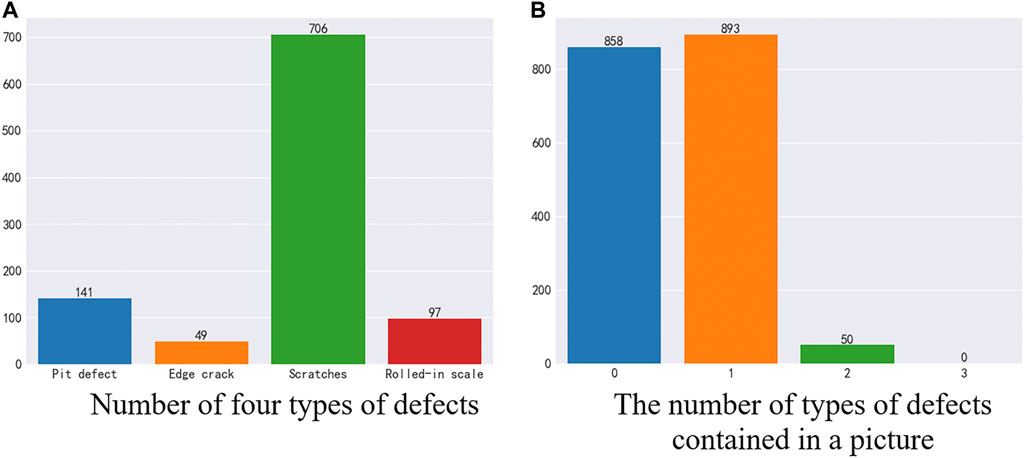
FIGURE 3. Test set analysis. (A) Number of four types of defects (B) The number of types of defects contained in a picture.
From the analysis of the data set, the number of defective and non-defective images is roughly the same. The number of different types of defects is unbalanced, but the corresponding proportions of defects in the training set and the test set are the same. And most images have no defects or only contain one type of defect. This brings great difficulties and challenges to neural network construction and network training.
3.1.2 Run-Length Encoding
Because the defect image has a resolution of 256 × 1600, the size is too large to limit the computing power and neural network model, and it also has a great impact on the detection of small defects. This paper uses Run-Length Encoding (RLE) algorithm to compress the data.
RLE is a simple lossless compression method, which is characterized by very fast compression and decompression (Li et al., 2021). This method uses repeated bytes and the number of repetitions to simply describe the repeated bytes, that is, a series of consecutive identical data is converted into a specific format to achieve the purpose of compression.
Meanwhile, in order to reduce the amount of calculation and compress the deep learning model, this paper uses the parameter quantization method to train the network, and uses FP32 and uint8 mixed training to reduce the memory usage and training time of the model.
3.1.3 Data Preprocessing
Data preprocessing is an essential step before neural network training and testing. The quality of preprocessing will directly determine the training results. Based on pytorch, this paper uses torchvision graphics library to process data sets.
The data were processed and enhanced by ColorJitter (modifying brightness, contrast and saturation), RandomVerticalFlip (flipping vertically around X axis according to probability), RandomHorizontalFlip (flipping horizontally around Y axis according to probability). Finally, the data were regularized [mean = (0.485, 0.456, 0.406), std = (0.229, 0.224, 0.225)] and normalized.
The data preprocessing settings are shown in Table 1.
In this section, the necessary analysis of the data set is carried out, and the data set is coded, decoded and processed to provide help for network training.
3.2 Model Evaluation Indicators and Parameter Settings
3.2.1 Evaluation Index
In the field of semantic segmentation, IoU(Intersection over Union), mIoU (mean Intersection over Union) and Dice are important evaluation indicators to measure the accuracy of image segmentation.
mIoU, i.e., calculating the IoU values on each category and then averaging them. It is calculated as TP (number of true samples)/[TP (number of true samples) + FN(number of false negative samples) + FN(number of false positive samples) numbers] (He et al., 2019; Cheng et al., 2020, 2021).
Equivalent to:
In which, i represents the true value, j represents the predicted value, represents the prediction of the i-type pixel as the j-type pixel, and k is the total number of categories. TP (True Positive) means that the prediction is correct and the prediction result is correct. FP (False Positive) means that the prediction is wrong and the prediction result is correct. FN (False Negative) means that the prediction is correct, but the prediction result is wrong.
Where, Dice is a common indicator in medical images. X represents the real result, Y represents the predicted result, and
3.2.2 Weighted Loss Function
In deep neural networks, the loss function is used as an important indicator to evaluate the accuracy of the model, which provides a reference for the network model to approach the high-precision direction (Zhang H. et al., 2021). Decreasing the Loss value of the network model can make the model more and more accurate and improve the robustness of the model. Common loss functions include logarithmic loss function, mean square error loss function (MSE), cross entropy loss function, and exponential loss function.
In the multi-label classification problem, the binary cross entropy loss function (BCE Loss) is the most common. BCE Loss is defined as follows:
In which, n represents the total number of samples in the training set,
Sigmoid is a differentiable bounded function with non-negative derivatives at every point. It is often used in binary classification problems, as well as the activation function of neural networks (Ma et al., 2020), that is, to convert linear input into non-linear output.
The form of the Sigmoid function is shown in Eq. 5. When
This paper will use BCEWithLogitsLoss as the loss function for the intelligent detection of steel defects. BCEWithLogitsLoss combines the BCELoss and Sigmoid functions into one category, which is numerically more stable than using ordinary BCELoss and Sigmoid.
3.2.3 Learning Rate Adjustment and Its Optimizer
If the initial learning rate is too large, it will cause oscillation; the initial learning rate is too small, resulting in slow convergence; the later learning rate is too large, it will cause overfitting. Therefore, in the training process, a dynamically changing learning rate is generally set according to the number of training rounds. The ideal strategy is to start with a large learning rate and gradually decay.
In this paper, the ReduceLROnPlateau method is used to dynamically update the learning rate, which is based on the number of epoch training times and some measurement values (loss, accaurcy, etc.) to dynamically decrease the learning rate.
Adaptive Moment Estimation (Adam) is an optimizer that converges quickly and is often used. Adam uses the first-order moment estimation and the second-order moment estimation of the gradient to dynamically adjust the learning rate (Liao et al., 2020; Liao et al., 2021; Jiang et al., 2019a). It is an optimisation method of adaptive learning rate. This paper uses Adam optimization method to continuously optimize the learning rate.
3.3 Defect Detection Network Structure
3.3.1 Backbone
He and others proposed residual network (ResNet; He et al., 2016), which has become one of the most widely used CNN basic feature extraction networks in the field of computer vision by introducing the concept of residual learning into CNN (He et al., 2014). The residual block introduced in ResNet solves the problem of network performance degradation caused by gradient dispersion in the process of continuous deepening of the network. The residual module structure of ResNet is shown in Figure 4.
During forward propagation, due to the existence of short-circuit connections, the deep and shallow features satisfy the relationship:
In which,
It can be seen that the residual module establishes a short-circuit connection between the input and output of the module through identity mapping, so that the gradient can be maintained during back propagation and the gradient dispersion phenomenon can be alleviated (Li et al., 2019b; Tan et al., 2020).
Meanwhile, ResNet uses a bottleneck structure to replace the original two 3 × 3 convolutions of the residual module, with significantly fewer parameters in the same input dimension. By stacking the basic units of the residual module, the depth of the network can break through the original limit and reach hundreds of layers.
Good performance of ResNet on image recognition and localization tasks showed that characterisation depth is of central importance for many visual recognition tasks. In the following years, excellent feature extraction networks such as ResNeXt, DenseNet, RegNet, SEnet, SKNet, etc (Xie et al., 2017; Liu X. et al., 2021; Liu et al., 2021b; Liu et al., 2021c; Liu et al., 2021d; Sun et al., 2020c; Sun et al., 2020d). were successively proposed, constantly refreshing the accuracy rate of tasks such as image classification. However, most of these detection algorithms have been studied based on ResNet for improvement.
3.3.2 Architectures
Target detection tasks and semantic segmentation tasks often need to detect small targets, and the data set in this article has small defect targets that need to be detected. However, in the deep learning model, after many layers of convolution, the characteristics of small targets will become fewer and smaller.
Feature Pyramid Networks (FPN) was proposed by Lin Tsung-Yi and others in 2017 (Lin et al., 2017). FPN introduces multi-scale in the feature pyramid network and improves on the basis of the SSD multi-layer branching method (Bai et al., 2021; Cui et al., 2021). Similar to the TDM (Top-Down Modulation) method, FPN is a top-down feature fusion method.
Feature pyramid networks is a multi-scale target detection algorithm, that is, there is more than one feature prediction layer. Although some algorithms also use multi-scale feature fusion for target detection, they often only use the features of one scale obtained after fusion. Although this approach can combine the semantic information of the top-level features and the detailed information of the bottom-level features, it will cause some deviations in the process of feature deconvolution, and only using the features obtained after fusion for prediction will adversely affect the detection accuracy (Huang et al., 2019; Jiang et al., 2019b). Starting from the above-mentioned problems, the FPN method can predict on multiple fusion features of different scales to maximize the detection accuracy.
As shown in Figure 5, the branches corresponding to the left half of the two networks in Figure 5 is the pre-trained network. Since the whole flow is bottom-up, it is called a bottom-up network. The entire flow of the branches corresponding to the right half of the two networks is top-down. The so-called top-down network is the core part of the FPN. The diagram shows (a) predictions for each layer of the network, and (b) predictions for the final layer after fusing the multi-scale features. In general, the (a) graph structure is widely used for target detection and semantic segmentation, while the (b) structure is more often used for semantic segmentation (Sun et al., 2021; Tao et al., 2022).
FPN uses a multi-feature fusion approach to improve the accuracy of the model. In this paper, FPN is applied to ResNeSt and improved and optimised accordingly to achieve better segmentation of steel surface defects.
3.4 DF-ResNeSt50
In 2020, Split-Attention Networks (ResNeSt) was proposed (Zhang M. et al., 2021). ResNeSt introduces the Split-Attention block, which consists of a feature map group and split attention operation.
The number of feature map groups is given by the cardinal hyperparameter k. The network refers to the generated feature map group as a cardinality array. And introduce a new base number called hyperparameter r, which represents the number of splits in the cardinal array. The total number of feature groups is G = kr, as shown in Figure 6.
The layout of Figure 6 is a cardinality master implementation, in which feature map groups with the same cardinality index are physically adjacent to each other. The cardinal implementation is simple and intuitive, but it is difficult to use standard operators for modularization and acceleration. For this reason, an equivalent base-first implementation has been introduced.
The combined representation of each cardinal group can be obtained by summing and fusing the elements across multiple splits. The representation of the kth cardinal group is:
Here the cth component is calculated as:
In which, each feature map channel is generated using a combination of weighted splits. H, W and C are the size of the block output feature map. The Eq. 10 for the cth channel is:
Where
Based on the weights of the global contextual information, mapping
Figure 7 outlines the split attention block in a radix-major layout. The input feature map is first divided into kr groups, where each group has a cardinality index and a radix index. In this layout, groups with the same cardinality index are adjacent to each other. The divisions of the different groups are then added together to combine feature maps with the same cardinality index but different cardinality indexes. The global pooling layer aggregates in the spatial dimension, keeping the channel dimensions separate, and performs global pooling on each individual cardinal array. Finally, two consecutive fully-connected (FC) layers with a group size equal to k are added after the pooling layer to predict the attention weights for each segmentation. The two FC layers are activated using BN and ReLU in between, and the use of grouped FC layers makes it identical to apply each pair of FCs to the top of each cardinal array separately.
With this implementation, the first 1 × 1 convolutional layer can be unified into a single layer, and the 3 × 3 convolutional layer can be implemented with a single grouped convolution of the kr number of groups. The Split attention module can therefore be modularised using standard operators to improve network efficiency easily and quickly.
In this paper, the FPN and ResNeSt are modified and fused to complete the network construction, and named DF-ResNeSt50. DF-ResNeSt50 uses Cardinality(k) = 2, Radix(r) = 4 and width of bottleneck = 40.
State-of-the-art performance can be achieved on multiple tasks using the improved ResNeSt backbone model, namely: image classification, target detection, instance segmentation and semantic segmentation (Huang et al., 2021; Jiang et al., 2019c). ResNeSt outperforms all existing variants of ResNet and has the same computational efficiency. Therefore, this paper uses DF-ResNeSt50 for network training.
4. Experimental Results and Analysis
4.1 Experimental Environment Configuration
The algorithm research and network training in this article are all carried out in the laboratory server. The specific computer system and experimental environment configuration used are shown in Table 2.
Based on the good ecology and scalability of the Python language and the open source framework PyTorch, this article uses a series of open source libraries and toolkits to implement the overall algorithm program (Neuhauser et al., 2020; Sun et al., 2020). Such as: Numpy, Albumentations, segmentation_models.pytorch semantic segmentation model library, etc.
These open source tools greatly save the development time of the defect detection and segmentation program in this article, so that more time and energy can be invested in the research, improvement and experiment of the algorithm.
4.2 Model Training
4.2.1 Hyperparameter Setting
Before model training, some parameters cannot be learned from data and need to be set in advance, which are hyperparameters. The setting of super parameters will directly affect the training process and the final performance of the model. In general, it is necessary to optimize the hyperparameters and select a group of optimal hyperparameters for the model network to improve the performance and effect of learning (Chen et al., 2021c; Liu et al., 2021e; 2021f; 2022).
At the same time, under certain conditions, the larger the batchsize, the better the training effect. Gradient accumulation realizes the disguised expansion of batchsize. The setting of this paper is accumulation_steps = 8.
DF-ResNeSt50 is divided into two versions, DF-ResNeSt50-V1 and DF-ResNeSt50-V2. The DF-ResNeSt50-V2 version is an improvement and optimization based on the network structure of the V1 version, from post-mask processing, data enhancement, hyperparameters, etc. to improvements and optimizations. The different settings are shown in Table 3.
This paper adopts ADAM optimizer to optimize learning rate and gradient descent in time. The evaluation indexes such as BCEwithLogitsloss, mIOU and DICE are introduced to evaluate the network.
4.2.2 Comparison of Training Results
The experiment trained a total of 6 network models: PSP (ResNeSt14), Unet (ResNeSt14), FPN (ResNet50), FPN (ResNeSt50), DF-ResNeSt50-V1, DF-ResNeSt50-V2. Each network is trained for 40 epochs (rounds), each epoch is about 17–22 min, and each network is trained for about 12–15 h.
The detection results of steel plate defects by different networks are shown in Table 4.
As shown in Table 4, among the 6 network models, the best network model is DF-ResNeSt50-V2. And, the Dice comparison of different network models is shown in Figure 8.
The BCE Loss, Dice and mIoU of DF-ResNeSt50-V1 and V2 are shown in Figures 9–14 respectively.
DF-ResNeSt50-V2 is in the 10th epoch reducing learning rate of group 0–1.00e-04. Therefore, a mutation occurred in the 10th epoch. In the training, we use the ReduceLROnPlateau method, BCEwithLogitsloss optimizer and loss function, so this mutation is normal.
In order to test the capability and effectiveness of the model, the effect of defect segmentation on the surface of the steel plate was visualised, with different defect types selected by different colour boxes. Figure 15 shows the visualisation of the defects in Figure 1.
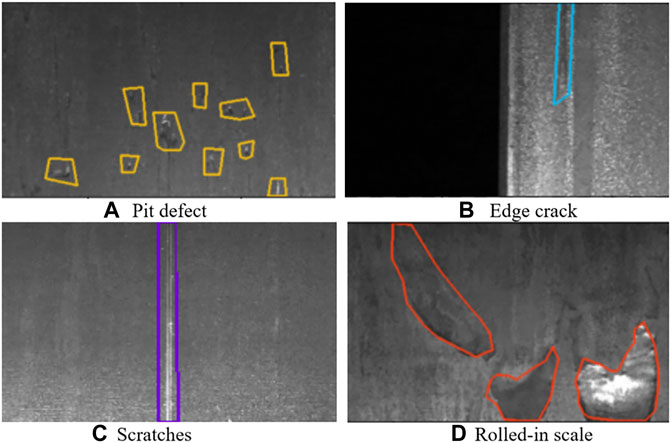
FIGURE 15. Defect detection segmentation effect. (A) Pit defect (B) Edge crack, (C) Scratches (D) Rolled-in scale.
After a series of network improvements and algorithm optimisation, the DF model in this paper achieves a mIOU of 77.15% and a DICE of 87.10%. It better meets the needs of defect detection in the actual steel production process and provides help for the next intelligent and efficient detection of defects.
5. Conclusion
In order to solve the problem of steel defects with different sizes, low contrast and different defect categories, this paper uses the DF-ResNeSt50 network model to investigate steel defects. By analyzing the surface defect data of the steel plate, the data is pre-processed with ColorJitter, Random VerticalFlip, Normalize, etc. Based on the visual attention mechanism in the bionic algorithm, this paper combined with feature pyramid networks and split attention network model, from the perspectives of data enhancement, multi-scale feature fusion and network structure optimization, etc., the DF-ResNeSt50 network model is proposed. DF-ResNeSt50 uses the radix-major implementation block (cardinality = 2, radix = 4, width of bottleneck = 40), which has better detection performance and detection efficiency compared with related networks. In the future, the correlation optimisation of the network can be applied in the direction of object detection, video detection, quality detection, scene semantic understanding, etc., with broad application prospects.
Data Availability Statement
The raw data supporting the conclusion of this article will be made available by the authors, without undue reservation.
Author Contributions
ZH and ZW provide research ideas and write programs for experiments. XT is responsible for collecting data and analyzing and interpreting the simulation results; BC improves the algorithm. DB, BT and BC, as corresponding authors, were responsible for writing the paper and approved the final submission.
Funding
This work was supported by the grants of the National Natural Science Foundation of China (Grant Nos. 52075530, 51575407, 51505349, 51975324, 61733011, 41906177); the Grants of Hubei Provincial Department of Education (D20191105); the Grants of National Defense Pre-Research Foundation of Wuhan University of Science and Technology (GF201705) and Open Fund of the Key Laboratory for Metallurgical Equipment and Control of Ministry of Education in Wuhan University of Science and Technology (2018B07, 2019B13) and Open Fund of Hubei Key Laboratory of Hydroelectric Machinery Design and Maintenance in Three Gorges University (2020KJX02, 2021KJX13).
Conflict of Interest
The authors declare that the research was conducted in the absence of any commercial or financial relationships that could be construed as a potential conflict of interest.
Publisher’s Note
All claims expressed in this article are solely those of the authors and do not necessarily represent those of their affiliated organizations, or those of the publisher, the editors and the reviewers. Any product that may be evaluated in this article, or claim that may be made by its manufacturer, is not guaranteed or endorsed by the publisher.
References
Bai, D., Sun, Y., Tao, B., Tong, X., Xu, M., Jiang, G., et al. (2021). Improved Single Shot Multibox Detector Target Detection Method Based on Deep Feature Fusion. Concurrency Computat Pract. Exper. doi:10.1002/cpe.6614
Çelik, H. İ., Dülger, L. C., and Topalbekiroğlu, M. (2014). Development of a Machine Vision System: Real-Time Fabric Defect Detection and Classification with Neural Networks. J. Textile Inst. 105 (6), 575–585. doi:10.1080/00405000.2013.827393
Chen, T., Peng, L., Yang, J., and Cong, G. (2021a). Analysis of User Needs on Downloading Behavior of English Vocabulary APPs Based on Data Mining for Online Comments. Mathematics 9 (12), 1341. doi:10.3390/math9121341
Chen, T., Rong, J., Yang, J., Cong, G., and Li, G. (2021b). Combining Public Opinion Dissemination with Polarization Process Considering Individual Heterogeneity. Healthcare 9 (2), 176. doi:10.3390/healthcare9020176
Chen, T., Yin, X., Peng, L., Rong, J., Yang, J., and Cong, G. (2021c). Monitoring and Recognizing enterprise Public Opinion from High-Risk Users Based on User Portrait and Random forest Algorithm. Axioms 10 (2), 106. doi:10.3390/axioms10020106
Cheng, Y., Li, G., Li, J., Sun, Y., Jiang, G., Zeng, F., et al. (2020). Visualization of Activated Muscle Area Based on sEMG. J. Intell. Fuzzy Syst. 38 (3), 2623–2634. doi:10.3233/jifs-179549
Cheng, Y., Li, G., Yu, M., Jiang, D., Yun, J., Liu, Y., et al. (2021). Gesture Recognition Based on Surface Electromyography ‐feature Image. Concurrency Computat Pract. Exper 33 (6), e6051. doi:10.1002/cpe.6051
Cui, L., Jiang, X., Xu, M., Li, W., Lv, P., and Zhou, B. (2021). SDDNet: A Fast and Accurate Network for Surface Defect Detection. IEEE Trans. Instrum. Meas. 70, 1–13. doi:10.1109/TIM.2021.3056744
Doulgkeroglou, M.-N., Di Nubila, A., Niessing, B., König, N., Schmitt, R. H., Damen, J., et al. (2020). Automation, Monitoring, and Standardization of Cell Product Manufacturing. Front. Bioeng. Biotechnol. 8, 811. doi:10.3389/fbioe.2020.00811
Duan, H., Sun, Y., Cheng, W., Jiang, D., Yun, J., Liu, Y., et al. (2021). Gesture Recognition Based on Multi‐modal Feature Weight. Concurrency Computat Pract. Exper 33 (5), e5991. doi:10.1002/cpe.5991
Gu, J., Gao, L., and Liu, L. (2019). Application of Target Detection Algorithm Based on Deep Learning in Cold Rolling Surface Defect Detection. Metallurgical automation (6), 25–28. doi:10.3969/j.issn.1000-7059.2019.06.004
Hao, Z., Wang, Z., Bai, D., and Zhou, S. (2021). Towards the Steel Plate Defect Detection: Multidimensional Feature Information Extraction and Fusion. Concurrency Computat Pract. Exper 33 (21), e6384. doi:10.1002/cpe.6384
He, K., Zhang, X., Ren, S., and Sun, J. (2016). Deep Residual Learning for Image Recognition. IEEE Conf. Computer Vis. Pattern Recognition (Cvpr), 770–778. doi:10.1109/CVPR.2016.90
He, K., Zhang, X., Ren, S., and Sun, J. (2014). Spatial Pyramid Pooling in Deep Convolutional Networks for Visual Recognition. IEEE Trans. Pattern Anal. Machine Intelligence 37 (9), 346–361. doi:10.1007/978-3-319-10578-9_23
He, Y., Li, G., Liao, Y., Sun, Y., Kong, J., Jiang, G., et al. (2019). Gesture Recognition Based on an Improved Local Sparse Representation Classification Algorithm. Cluster Comput. 22 (Suppl. 5), 10935–10946. doi:10.1007/s10586-017-1237-1
He, Y., Song, K., Meng, Q., and Yan, Y. (2020). An End-To-End Steel Surface Defect Detection Approach via Fusing Multiple Hierarchical Features. IEEE Trans. Instrum. Meas. 69 (4), 1493–1504. doi:10.1109/TIM.2019.2915404
Huang, L., Fu, Q., He, M., Jiang, D., and Hao, Z. (2021). Detection Algorithm of Safety Helmet Wearing Based on Deep Learning. Concurrency Computat Pract. Exper 33 (13), e6234. doi:10.1002/cpe.6234
Huang, L., Fu, Q., Li, G., Luo, B., Chen, D., and Yu, H. (2019). Improvement of Maximum Variance Weight Partitioning Particle Filter in Urban Computing and Intelligence. IEEE Access 7, 106527–106535. doi:10.1109/ACCESS.2019.2932144
Huang, L., He, M., Tan, C., Jiang, D., Li, G., and Yu, H. (2020). Jointly Network Image Processing: Multi‐task Image Semantic Segmentation of Indoor Scene Based on CNN. IET image process 14 (15), 3689–3697. doi:10.1049/iet-ipr.2020.0088
Jawahar, M., Babu, N. K. C., Vani, K., Anbarasi, L. J., and Geetha, S. (2020). Vision Based Inspection System for Leather Surface Defect Detection Using Fast Convergence Particle Swarm Optimization Ensemble Classifier Approach. Multimed Tools Appl. 80 (3), 4203–4235. doi:10.1007/s11042-020-09727-3
Jiang, D., Li, G., Sun, Y., Hu, J., Yun, J., and Liu, Y. (2021a). Manipulator Grabbing Position Detection with Information Fusion of Color Image and Depth Image Using Deep Learning. J. Ambient Intell. Hum. Comput 12 (12), 10809–10822. doi:10.1007/s12652-020-02843-w
Jiang, D., Li, G., Sun, Y., Kong, J., Tao, B., and Chen, D. (2019b). Grip Strength Forecast and Rehabilitative Guidance Based on Adaptive Neural Fuzzy Inference System Using sEMG. Pers Ubiquit Comput. doi:10.1007/s00779-019-01268-3
Jiang, D., Li, G., Sun, Y., Kong, J., and Tao, B. (2019a). Gesture Recognition Based on Skeletonization Algorithm and CNN with ASL Database. Multimed Tools Appl. 78 (21), 29953–29970. doi:10.1007/s11042-018-6748-0
Jiang, D., Li, G., Tan, C., Huang, L., Sun, Y., and Kong, J. (2021b). Semantic Segmentation for Multiscale Target Based on Object Recognition Using the Improved Faster-RCNN Model. Future Generation Computer Syst. 123, 94–104. doi:10.1016/j.future.2021.04.019
Jiang, D., Zheng, Z., Li, G., Sun, Y., Kong, J., Jiang, G., et al. (2019c). Gesture Recognition Based on Binocular Vision. Cluster Comput. 22 (Suppl. 6), 13261–13271. doi:10.1007/s10586-018-1844-5
Li, C., Li, G., Jiang, G., Chen, D., and Liu, H. (2020). Surface EMG Data Aggregation Processing for Intelligent Prosthetic Action Recognition. Neural Comput. Applic 32 (22), 16795–16806. doi:10.1007/s00521-018-3909-z
Li, G., Jiang, D., Zhou, Y., Jiang, G., Kong, J., and Manogaran, G. (2019a). Human Lesion Detection Method Based on Image Information and Brain Signal. IEEE Access 7, 11533–11542. doi:10.1109/ACCESS.2019.2891749
Li, G., Li, J., Ju, Z., Sun, Y., and Kong, J. (2019b). A Novel Feature Extraction Method for Machine Learning Based on Surface Electromyography from Healthy Brain. Neural Comput. Applic 31 (12), 9013–9022. doi:10.1007/s00521-019-04147-3
Li, J., Wang, P., Zhou, Y., Liang, H., and Luan, K. (2021). Different Machine Learning and Deep Learning Methods for the Classification of Colorectal Cancer Lymph Node Metastasis Images. Front. Bioeng. Biotechnol. 8, 620257. doi:10.3389/fbioe.2020.620257
Li, Y., Zhao, W., and Pan, J. (2017). Deformable Patterned Fabric Defect Detection with fisher Criterion-Based Deep Learning. IEEE Trans. Automat. Sci. Eng. 14 (2), 1256–1264. doi:10.1109/TASE.2016.2520955
Liao, S., Li, G., Li, J., Jiang, D., Jiang, G., Sun, Y., et al. (2020). Multi-object Intergroup Gesture Recognition Combined with Fusion Feature and KNN Algorithm. J. Intell. Fuzzy Syst. 38 (3), 2725–2735. doi:10.3233/jifs-179558
Liao, S., Li, G., Wu, H., Jiang, D., Liu, Y., Yun, J., et al. (2021). Occlusion Gesture Recognition Based on Improved SSD. Concurrency Computat Pract. Exper 33 (6), e6063. doi:10.1002/cpe.6063
Lin, T.-Y., Dollar, P., Girshick, R., He, K., Hariharan, B., and Belongie, S. 2017). “Feature Pyramid Networks for Object Detection,” in Proceeding of the IEEE Conference on Computer Vision and Pattern Recognition (CVPR), Honolulu, HI, USA, 21-26 July 2017 (IEEE), 936–944.doi:10.1109/CVPR.2017.106
Liu, X., Jiang, D., Tao, B., Jiang, G., Sun, Y., Kong, J., et al. (2021a). Genetic Algorithm-Based Trajectory Optimization for Digital Twin Robots. Front. Bioeng. Biotechnol. doi:10.3389/fbioe.2021.793782
Liu, Y., Jiang, D., Duan, H., Sun, Y., Li, G., Tao, B., et al. (2021b). Dynamic Gesture Recognition Algorithm Based on 3D Convolutional Neural Network. Comput. Intelligence Neurosci.. doi:10.1155/2021/4828102
Liu, Y., Jiang, D., Tao, B., Qi, J., Jiang, G., Yun, J., et al. (2022). Grasping Posture of Humanoid Manipulator Based on Target Shape Analysis and Force Closure. Alexandria Eng. J. 61 (5), 3959–3969. doi:10.1016/j.aej.2021.09.017
Liu, Y., Jiang, D., Yun, J., Sun, Y., Li, C., Jiang, G., et al. (2021e). Self-tuning Control of Manipulator Positioning Based on Fuzzy PID and PSO Algorithm. Front. Bioeng. Biotechnol. doi:10.3389/fbioe.2021.817723
Liu, Y., Li, C., Jiang, D., Chen, B., Sun, N., Cao, Y., et al. (2021c). Wrist Angle Prediction under Different Loads Based on GA‐ELM Neural Network and Surface Electromyography. Concurrency Computat Pract. Exper, e6574. doi:10.1002/CPE.6574
Liu, Y., Xiao, F., Tong, X., Tao, B., Xu, M., Jiang, G., et al. (2021f). Manipulator Trajectory Planning Based on Work Subspace Division. Concurrency Computat Pract. Exper, e6710. doi:10.1002/CPE.6710
Liu, Y., Xu, M., JiangTong, G. X., Yun, J., Liu, Y., Chen, B., et al. (2021d). Target Localization in Local Dense Mapping Using RGBD SLAM and Object Detection. Concurrency Comput. Pract. Experience, e6655. doi:10.1002/CPE.6655
Long, J., Shelhamer, E., and Darrell, T. (2015). Fully Convolutional Networks for Semantic Segmentation. IEEE Trans. Pattern Anal. Machine Intelligence 39 (4), 640–651. doi:10.1109/CVPR.2015.7298965
Luo, B., Sun, Y., Li, G., Chen, D., and Ju, Z. (2020). Decomposition Algorithm for Depth Image of Human Health Posture Based on Brain Health. Neural Comput. Applic 32 (10), 6327–6342. doi:10.1007/s00521-019-04141-9
Ma, R., Zhang, L., Li, G., Jiang, D., Xu, S., and Chen, D. (2020). Grasping Force Prediction Based on sEMG Signals. Alexandria Eng. J. 59 (3), 1135–1147. doi:10.1016/j.aej.2020.01.007
Neuhauser, F. M., Bachmann, G., and Hora, P. (2020). Surface Defect Classification and Detection on Extruded Aluminum Profiles Using Convolutional Neural Networks. Int. J. Mater. Form 13 (3), 591–603. doi:10.1007/s12289-019-01496-1
Sun, Y., Hu, J., Li, G., Jiang, G., Xiong, H., Tao, B., et al. (2020b). Gear Reducer Optimal Design Based on Computer Multimedia Simulation. J. Supercomput 76 (6), 4132–4148. doi:10.1007/s11227-018-2255-3
Sun, Y., Tian, J., Jiang, D., Tao, B., Liu, Y., Yun, J., et al. (2020d). Numerical Simulation of thermal Insulation and Longevity Performance in New Lightweight Ladle. Concurrency Computat Pract. Exper 32 (22), e5830. doi:10.1002/cpe.5830
Sun, Y., Weng, Y., Luo, B., Li, G., Tao, B., Jiang, D., et al. (2020a). Gesture Recognition Algorithm Based on Multi‐scale Feature Fusion in RGB‐D Images. IET image process 14 (15), 3662–3668. doi:10.1049/iet-ipr.2020.0148
Sun, Y., Xu, C., Li, G., Xu, W., Kong, J., Jiang, D., et al. (2020c). Intelligent Human Computer Interaction Based on Non Redundant EMG Signal. Alexandria Eng. J. 59 (3), 1149–1157. doi:10.1016/j.aej.2020.01.015
Sun, Y., Yang, Z., Tao, B., Jiang, G., Hao, Z., and Chen, B. (2021). Multiscale Generative Adversarial Network for Real‐world Super‐resolution. Concurrency Computat Pract. Exper 33 (21), e6430. doi:10.1002/CPE.6430
Tan, C., Sun, Y., Li, G., Jiang, G., Chen, D., and Liu, H. (2020). Research on Gesture Recognition of Smart Data Fusion Features in the IoT. Neural Comput. Applic 32 (22), 16917–16929. doi:10.1007/s00521-019-04023-0
Tang, B., Kong, J., and Wu, S. (2017). Review of Surface Defect Detection Based on Machine Vision. J. Image Graphics 22 (12), 1640–1663. doi:10.11834/jig.160623
Tao, B., Liu, Y., Huang, L., Chen, G., and Chen, B. (2022). 3D Reconstruction Based on Photoelastic Fringes. Concurrency Computat Pract. Exper 34 (1), e6481. doi:10.1002/CPE.6481
Tian, J., Cheng, W., Sun, Y., Li, G., Jiang, D., Jiang, G., et al. (2020). Gesture Recognition Based on Multilevel Multimodal Feature Fusion. J. Intell. Fuzzy Syst. 38 (3), 2539–2550. doi:10.3233/jifs-179541
Weng, Y., Sun, Y., Jiang, D., Tao, B., Liu, Y., Yun, J., et al. (2021). Enhancement of Real‐time Grasp Detection by Cascaded Deep Convolutional Neural Networks. Concurrency Computat Pract. Exper 33 (5), e5976. doi:10.1002/cpe.5976
Xiao, F., Li, G., Jiang, D., Xie, Y., Yun, J., Liu, Y., et al. (2021). An Effective and Unified Method to Derive the Inverse Kinematics Formulas of General Six-DOF Manipulator with Simple Geometry. Mechanism Machine Theor. 159, 104265. doi:10.1016/j.mechmachtheory.2021.104265
Xie, S., Girshick, R., Dollar, P., Tu, Z., and He, K. (2017). Aggregated Residual Transformations for Deep Neural Networks. IEEE Conf. Computer Vis. Pattern Recognition(CVPR), 5987–5995. doi:10.1109/CVPR.2017.634
Yang, Z., Jiang, D., Sun, Y., Tao, B., Tong, X., Jiang, G., et al. (2021). Dynamic Gesture Recognition Using Surface EMG Signals Based on Multi-Stream Residual Network. Front. Bioeng. Biotechnol. 9. doi:10.3389/fbioe.2021.779353
Yu, M., Li, G., Jiang, D., Jiang, G., Tao, B., and Chen, D. (2019). Hand Medical Monitoring System Based on Machine Learning and Optimal EMG Feature Set. Pers Ubiquit Comput., 9983. doi:10.1007/s00779-019-01285-2
Yu, M., Li, G., Jiang, D., JiangZeng, G., Zeng, F., Zhao, H., et al. (2020). Application of PSO-RBF Neural Network in Gesture Recognition of Continuous Surface EMG Signals. J. Intell. Fuzzy Syst. 38 (3), 2469–2480. doi:10.3233/jifs-179535
Yun, J., Sun, Y., Jiang, D., Tao, B., Jiang, G., Kong, J., et al. (2021). Attitude Estimation of Objects to Be Grasped Based on Fusion of Stereo Vision and Genetic Algorithm. Front. Bioeng. Biotechnol. doi:10.3389/fbioe.2021.845901
Yun, J., Sun, Y., Li, C., Jiang, D., Tao, B., Li, G., et al. (2022). Self-adjusting Force/bit Blending Control Based on Quantitative Factor-Scale Factor Fuzzy-PID Bit Control. Alexandria Eng. J. 61 (6), 4389–4397. doi:10.1016/j.aej.2021.09.067
Zhang, H., Wu, C., Zhang, Z., Zhu, Y., Zhang, Z., Lin, H., et al. (2021a). ResNeSt: Split-Attention Networks. Available at: https://arxiv.org/abs/2004.08955.
Zhang, M., Conti, F., Le Sourne, H., Vassalos, D., Kujala, P., Lindroth, D., et al. (2021b). A Method for the Direct Assessment of Ship Collision Damage and Flooding Risk in Real Conditions. Ocean Eng. 237, 109605. doi:10.1016/j.oceaneng.2021.109605
Keywords: defect detection, target identification, attention mechanism, feature extraction and fusion, split attention networks
Citation: Hao Z, Wang Z, Bai D, Tao B, Tong X and Chen B (2022) Intelligent Detection of Steel Defects Based on Improved Split Attention Networks. Front. Bioeng. Biotechnol. 9:810876. doi: 10.3389/fbioe.2021.810876
Received: 08 November 2021; Accepted: 24 December 2021;
Published: 13 January 2022.
Edited by:
Tinggui Chen, Zhejiang Gongshang University, ChinaReviewed by:
Jiawen Shi, Hangzhou Vocational and Technical College, ChinaWang Yulong, Xidian University, China
Copyright © 2022 Hao, Wang, Bai, Tao, Tong and Chen. This is an open-access article distributed under the terms of the Creative Commons Attribution License (CC BY). The use, distribution or reproduction in other forums is permitted, provided the original author(s) and the copyright owner(s) are credited and that the original publication in this journal is cited, in accordance with accepted academic practice. No use, distribution or reproduction is permitted which does not comply with these terms.
*Correspondence: Dongxu Bai, YmFpZG9uZ3h1QHd1c3QuZWR1LmNu; Xiliang Tong, dG9uZ3hpbGlhbmdAd3VzdC5lZHUuY24=; Baojia Chen, Y2JqaWFAMTYzLmNvbQ==
 Zhiqiang Hao1,2,3
Zhiqiang Hao1,2,3 Dongxu Bai
Dongxu Bai Bo Tao
Bo Tao Xiliang Tong
Xiliang Tong Baojia Chen
Baojia Chen
